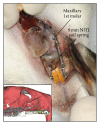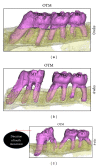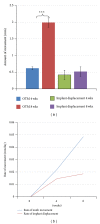A Novel Rat Model of Orthodontic Tooth Movement Using Temporary Skeletal Anchorage Devices: 3D Finite Element Analysis and In Vivo Validation
- PMID: 25295060
- PMCID: PMC4177079
- DOI: 10.1155/2014/917535
A Novel Rat Model of Orthodontic Tooth Movement Using Temporary Skeletal Anchorage Devices: 3D Finite Element Analysis and In Vivo Validation
Abstract
The aim of this animal study was to develop a model of orthodontic tooth movement using a microimplant as a TSAD in rodents. A finite element model of the TSAD in alveolar bone was built using μCT images of rat maxilla to determine the von Mises stresses and displacement in the alveolar bone surrounding the TSAD. For in vivo validation of the FE model, Sprague-Dawley rats (n = 25) were used and a Stryker 1.2 × 3 mm microimplant was inserted in the right maxilla and used to protract the right first permanent molar using a NiTi closed coil spring. Tooth movement measurements were taken at baseline, 4 and 8 weeks. At 8 weeks, animals were euthanized and tissues were analyzed by histology and EPMA. FE modeling showed maximum von Mises stress of 45 Mpa near the apex of TSAD but the average von Mises stress was under 25 Mpa. Appreciable tooth movement of 0.62 ± 0.04 mm at 4 weeks and 1.99 ± 0.14 mm at 8 weeks was obtained. Histological and EPMA results demonstrated no active bone remodeling around the TSAD at 8 weeks depicting good secondary stability. This study provided evidence that protracted tooth movement is achieved in small animals using TSADs.
Figures









References
-
- Krishnan V, Davidovitch Z. Cellular, molecular, and tissue-level reactions to orthodontic force. American Journal of Orthodontics and Dentofacial Orthopedics. 2006;129(4):469.e1–469.e32. - PubMed
-
- Karras JC, Miller JR, Hodges JS, Beyer JP, Larson BE. Effect of alendronate on orthodontic tooth movement in rats. The American Journal of Orthodontics and Dentofacial Orthopedics. 2009;136(6):843–847. - PubMed
-
- Gonzales C, Hotokezaka H, Yoshimatsu M, Yozgatian JH, Darendeliler MA, Yoshida N. Force magnitude and duration effects on amount of tooth movement and root resorption in the rat molar. Angle Orthodontist. 2008;78(3):502–509. - PubMed
-
- Drevenek M, Volk J, Sprogar S, Drevenek G. Orthodontic force decreases the eruption rate of rat incisors. European Journal of Orthodontics. 2009;31(1):46–50. - PubMed
LinkOut - more resources
Full Text Sources
Other Literature Sources
Miscellaneous

